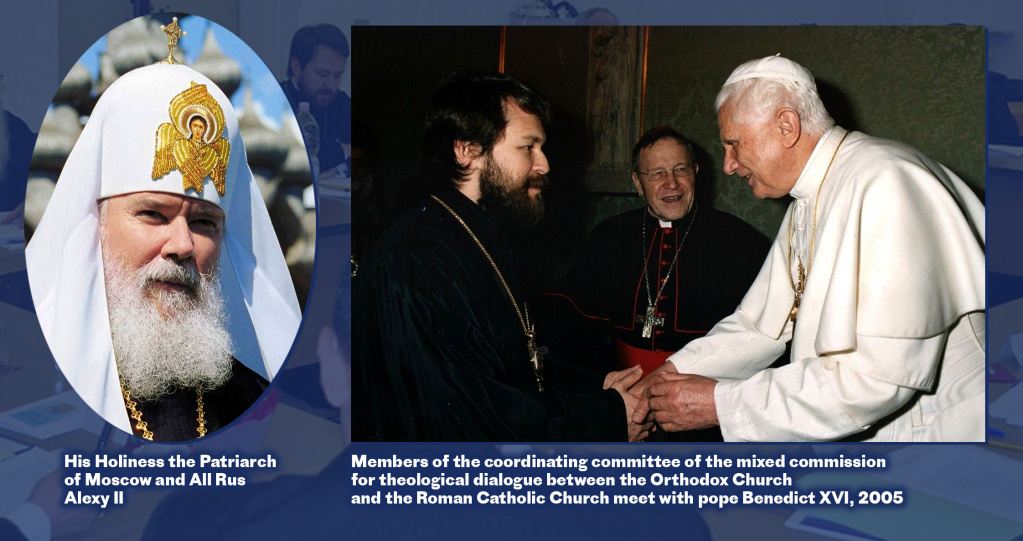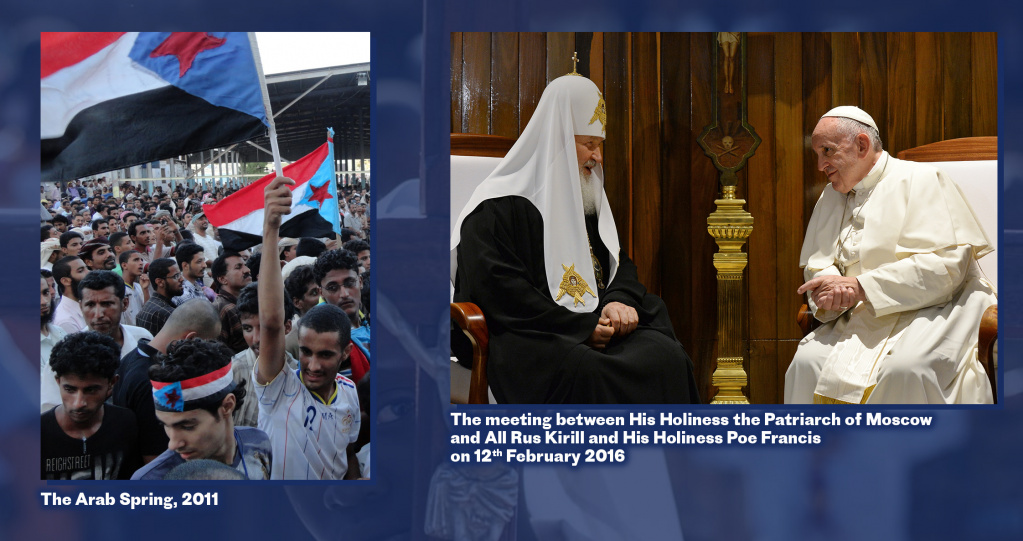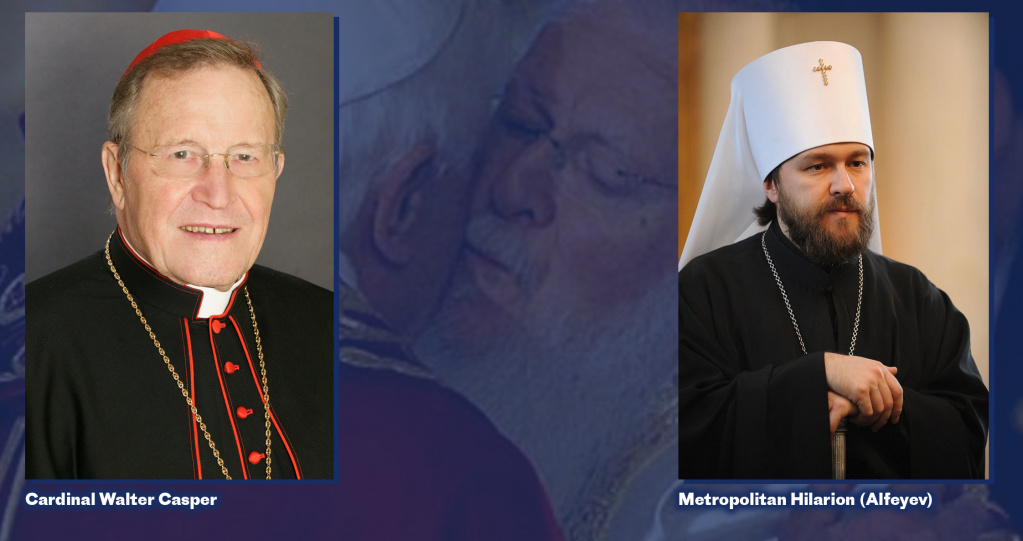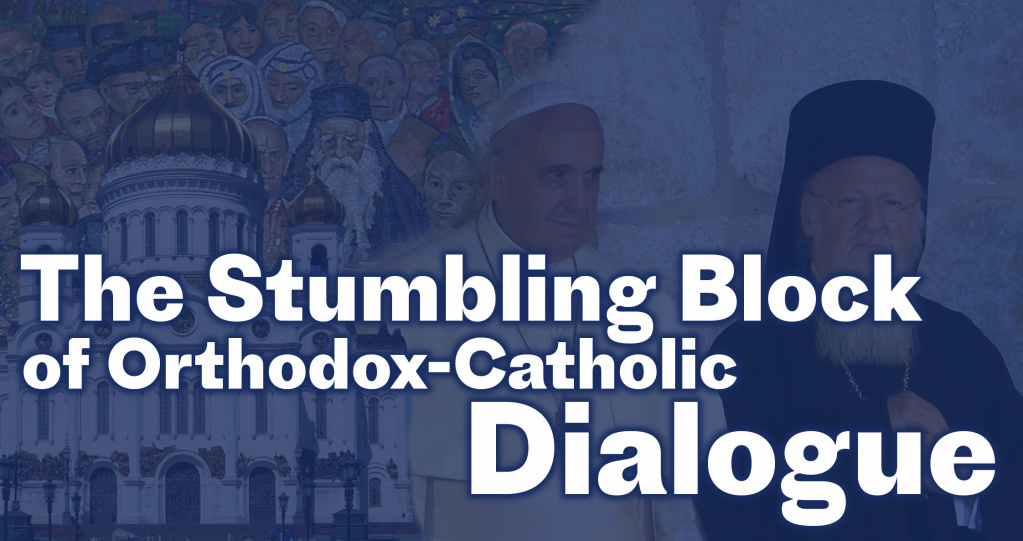The Stumbling Block of Orthodox-Catholic Dialogue
Danil Arakelyan
Today, one of the Russian Orthodox Church’s main partners on the international scene is the Roman Catholic Church. This may surprise those who take no special interest in inter-church dialogue and who know only about the historical enmity between Catholics and the Orthodox. Nonetheless, relations between the Holy See and the Moscow Patriarchate have indeed been greatly transformed over the past recent decades. And in order to have a better understanding of this we have to look at the close of the twentieth century.
The coming together of the Orthodox and the Catholics, which began in the 1960s, for a long time was based upon theological dialogue. However, when they embarked upon this course it was not theological issues that the two sides were interested in resolving. The mixed international commission on theological dialogue, which before the 1990s replaced the series of bilateral dialogues, concerned itself with issues that caused the least controversy.
At the initiative of the Russian Church, the last decade of the twentieth century was supposed to begin with sorting out the more complex problems of church order and the church’s canonical structure. It was an irony of fate that the tragic events at the turn of this decade enabled this process.
Liberalization in the countries of Eastern Europe, along with the collapse of the Soviet Union, led to the rebirth of Uniate structures in this part of the world. The Ukrainian Greek Catholic Church (UGCC) was especially active. Having received legal status at the end of 1989, the UGCC already by June of 1990 had taken under its control 1303 church buildings, most of which before this had belonged to the Moscow Patriarchate [10, p.567]. As His Holiness Patriarch Alexy II noted at the Episcopal Council of the Russian Orthodox Church in 1997, the Greek Catholics had violently seized Orthodox church buildings “by driving out with the help of pro-Uniate local authorities Orthodox communities and priests” [1]. On the whole, the activities of the Uniates led to a weakening of the Ukrainian Orthodox Church of the Moscow Patriarchate in Western Ukraine. But the UGCC did not stop at this. An “exarchate of Kiev” was established and Uniates began to infiltrate lands where historically the Orthodox were in the majority. The Ukrainian Greek Catholics had already begun to lay claim to the status of being a national church of Ukraine.
An ambiguous situation arose for the fate of Orthodox-Catholic dialogue. On the one hand, the Catholic Church officially called the Orthodox Churches “sisters” and held theological dialogue with them. On the other hand, part of the same Catholic Church was forcibly removing the Orthodox from their churches, provoking violence and hatred. As a result, the Orthodox-Catholic dialogue was suspended and completely redirected towards discussing the problem of the Unia. Over the next ten years three sessions of the mixed commission were held in Freising (1990), in Balamand (1993) and in Baltimore (2000) on the topic of the Uniate Church. Practically every year there were meetings between delegations of the Russian Orthodox Church and the Roman Catholic Church aimed at regulating the situation in Western Ukraine. Nonetheless, in spite of the two sides declaring that they “reject Uniatism as a means of seeking unity as it contradicts the common tradition of our Churches” [13, p.309], it transpired impossible to solve this issue once and for all. On the part of the Uniates there was neither any return of property, or a softening of the rhetoric or the curtailing of expansion.

Parallel to this, the end of the twentieth century became a time of the rebirth of Roman Catholic structures proper on the canonical territory of the Russian Orthodox Church. This was not, however, restricted to a mere restoration. As the Catholics themselves later admitted, there were instances of Catholic priests “behaving inappropriately” or, to use the language of the Moscow Patriarchate, instances of proselytism, that is, active missionary work among members of another Church [9]. The result of these actions of the Roman Catholic Church was that according to individual accounts the number of Catholics in Russia by the beginning of the twenty-first century had risen to a million people [12, p.135].
In summing up the relationship between the Russian Orthodox Church and the Vatican by the middle of the 2000s, the chairman of the Department for External Church Relations the metropolitan of Smolensk and Kaliningrad Kirill noted that they “were on the verge of complete collapse” [7]. At this time, without consulting the Russian Orthodox Church, the Vatican declared that it would raise the status of the Catholic Apostolic Administration in Russia to that of comprising dioceses, and it established new Catholic dioceses in Ukraine and in Kazakhstan. Simultaneously, the UGCC set up the Donetsk-Kharkiv and Odessa-Crimean exarchates and once more raised the issue of creating a Ukrainian Uniate Patriarchate.
In these conditions when multilateral dialogue had all but been extinguished, when bilateral interaction had not brought about the expected results, the Russian Orthodox and Roman Catholic Churches were able to transform the format of their relationship so that today they may be characterized as having formed a “strategic alliance” [6].
This transformation came about for a number of reasons. Firstly, the number of Catholics in Russia [14] had become less and the process of Unia had slowed down [15], thereby ensuring an amelioration of the problems which had beguiled the relationship between the Moscow Patriarchate and the Vatican in the preceding period.
Secondly, both Churches had encountered new challenges which had forced them into cooperation. This was been mainly the persecution of Christians in the Middle East and in Africa. After the US invasion of Iraq in 2003 and especially after the beginning of the Arab Spring in 2011, the ancient Christian populace of the Levant encountered persecution on religious grounds. They became the objects of widescale coordinated humanitarian aid. As a result of this, the Russian Church and the Vatican became closer. Evidence of this was that a significant part of the joint declaration of pope Francis and Patriarch Kirill in 2016 was devoted to the topic of protecting Christians from new persecutions.

Another challenge which the Christian world has had to confront is the onslaught of aggressive secularism. While many Western religious denominations have preferred to take the path of accommodating their legacy to the changing reality, the Orthodox, Catholics and conservative Protestants have embarked upon the path of vindicating traditional Christian values. Although it is quite difficult to evaluate the effectiveness of working together in this direction, the fact that Orthodox and Catholics’ views coincide has prompted them into seeking out new forms of interaction and into coming to some form of agreement between themselves.
If we are to look at the interaction of the Holy See and the Moscow Patriarchate more widely, then we may find that today the relationship has become more organized than it was thirty years ago. At the present time there exists a working group for relations between the Roman Catholic Church and the Russian Orthodox Church, both sides are a part of the Christian interconfessional consultative council and are in constant contact with each other. All the more so as it is not only the Catholics who are interested in this, who have increased their presence in Russia since the turn of the twenty-first century, but also the faithful of the Moscow Patriarchate, whose number has also increased in countries where Catholics comprise the majority, which to no small degree enabled the restoration of communion with the Russian Orthodox Church Abroad in 2007 and the return of the archdiocese of Western European parishes of the Russian tradition in 2019. Catholics and Orthodox today are less confined by the borders of separate nation states, and as a result life itself has nudged them towards a cooperation which has in recent years taken on a more institutional shape.
However, we have to recognize that the crisis in worldwide Orthodoxy is one of the most important factors in the relationship between the Russian Orthodox Church and the Roman Catholic Church today, all the more so as it has influenced Orthodox-Catholic relations long before it spilled over into an open form in 2018 as a result of the situation in Ukraine.
We can see this from the example of how the multilateral Orthodox-Catholic theological dialogue developed in the twentieth century. Then, unable to resolve the issue of the Unia, the two sides decided to apply themselves to no less complex issues such as ecclesiology. The sharp divides within this problem immediately highlighted the lack of unity within the Orthodox Churches. At the first session devoted to this problem in Belgrade in 2006 a scandal erupted. The controversy was caused by the following phrase: “After the rupture of the eleventh century, both Churches continued to hold ‘common’ councils which were attended by bishops of Local Churches in communion with the Holy See and by bishops of Local Churches which were in communion with the see of Constantinople.” The Russian Church, represented by the bishop of Vienna and Budapest Hilarion (Alfeyev), spoke out against this formula, noting that “communion with the see of Constantinople has never been taken to mean a definite condition for conciliarity in the same communion with the see of Rome has for Western Churches.” Nonetheless, in the absence of a consensus, the commission’s co-chairman cardinal Walter Casper proposed that this phrase be voted upon having been changed only slightly but in essence not having been changed at all. The Moscow Patriarchate was obliged to express its protest against this procedure of conducting dialogue by referring to the “inadmissibility of resolving issues of a dogmatic and ecclesiological nature by means of a vote” [2].

The two sides were to return to a discussion of this issue at a session in Ravenna in 2007. However, as a result of the provocation on the part of the Patriarchate of Constantinople which had included in its delegation a representative of the non-canonical so-called ‘Estonian Apostolic Church’ which the Phanar had set up on the canonical territory of the Moscow Patriarchate, the Russian Orthodox Church was obliged to leave the session and no longer take part in its work. The ‘Ravenna Document’ which emerged from this session and which contained the controversial formulation did not meet with the approval of the Russian Church, which by 2013 had already prepared its own document entitled ‘The Position of the Moscow Patriarchate on the Issue of Primacy in the Universal Church’.
This document accorded the Church of Constantinople the “primacy of honour”, the content of which, however, was defined by the “consensus of the Orthodox Churches” [8]. Thus, if the Phanar (and indirectly Rome) insisted that it enjoys certain rights on a Universal or pan-Orthodox level in itself, then the Russian Church insisted that the source of the possible rights of a presiding Church can only be the agreement in each concrete instance of all the other Local Churches.
In spite of the divisive nature of the issue, for a time it seemed that the conflict had been extinguished. This wrong impression surfaced in 2018 as a result of the crisis in Ukraine. In these conditions the Holy Synod of the Russian Orthodox Church decided to suspend the participation of the Moscow Patriarchate “in all episcopal gatherings, theological dialogues, multilateral commissions and other structures in which representatives of the Patriarchate of Constantinople preside or co-preside” [3]. This meant that the theological dialogue of the Churches of Russia and Rome was also suspended. Summarizing things as they are now, the metropolitan of Volokolamsk Hilarion has stated that the Orthodox-Catholic dialogue today finds itself “in a blind alley” [5].
As it develops its relationship today with the Roman Catholic Church, the Moscow Patriarchate has to take into account the following factors. On the one hand, we can observe on both sides the will to cooperate in the most varies spheres, bilateral institutions are working and the acuteness of past conflict has been considerably lessened. Not to be discounted too is the high quality of the relationship which was bolstered by the historical meeting between pope Francis and Patriarch Kirill in Havana in 2016 and which manifests itself in the joint work of the two Churches in supporting persecuted Christians and the defense of Christian values.
At the same time, the old challenges still remain. The issue of Unia has yet to be resolved and even the chairman of the Department of External Church Relations of the Moscow Patriarchate the metropolitan of Volokolamsk Hilarion continues to call it a “stumbling block” in the Orthodox-Catholic dialogue [4]. The crisis in inter-Orthodox relations also continues to reflect negatively on the interaction between the Russian Church and the Vatican. The situation is made complex by the fact that these problems touch upon theological subjects and for their resolution they require the conditional consensus of the all the Orthodox Churches, which in the foreseeable future looks unlikely. The long-term planning of relations in conditions when fundamental issues remain unresolved is impossible, but their improvement or deterioration will depend upon the changing environment. This is demonstrated by the fact that the present-day strategic alliance between the Moscow Patriarchate and the Holy See reacts above all to external challenges. Long-term cooperation, though, will inevitably require a resetting of the theological dialogue.
Literature
1. Speech by His Holiness Patriarch Alexy at the Episcopal Council of 1997 (in Russian) http://www.patriarchia.ru/db/text/421718.html (sourced on: 10.08.2021).
2. Bishop Hilarion makes protest to cardinal Walter Casper on the procedure of conducting Orthodox-Catholic dialogue (in Russian) http://www.patriarchia.ru/db/text/145204.html (sourced on: 10.08.2021).
3. Minute no.69 from the session of the Holy Synod on 14th September (in Russian).
4. Metropolitan of Volokolamsk Hilarion: “The Unia continues to remain the main stumbling block in Orthodox-Catholic dialogue” (in Russian). http://www.patriarchia.ru/db/text/4616459.html (sourced on: 10.08.2021)
5. Metropolitan Hilarion: “The patriarch of Constantinople has led the Orthodox-Catholic dialogue into a blind alley” (in Russian). https://mospat.ru/ru/news/87722/ (sourced on: 10.08.2021).
6. Metropolitan Hilarion: “Working together for the defense of Christianity” (in Russian) https://www.vaticannews.va/ru/church/news/2020-02/mitropolit-ilarion-rabotat-vmeste-dlya-zashity-hristianstva.html (sourced on: 10.08.2021).
7. Decision by the Holy Episcopal Council on external activities issues (in Russian). http://www.patriarchia.ru/db/text/418906.html (sourced on: 26.04.2019).
8. ‘The position of the Moscow Patriarchate on the issue of primacy in the Universal Church’ (in Russian). http://www.patriarchia.ru/db/text/3481089.html sourced on: 10.08.2021).
9. Ye. S. Speranskaya, ‘Theological dialogues of the Russian Orthodox Church’ (in Russian) in Pravoslavnaya entsiklopediya. https://www.pravenc.ru/text/171923.html (sourced on: 10.08.2021)
10. A. Tamborra, Katolicheskaya tserkov i russkoe pravoslavie (The Catholic Church and Russian Orthodoxy), Moscow, 2007, p.631.
12. A. Yudin, ‘The Catholic Challenge to Globalization in Eurasia’ (in Russian) in Religiya i globalizatsiya na prostorakh Evrazii, edited by A. Malashenko and S. Filatov, Moscow, 2005, pp.126-175.
13. A. Yudin, Pravoslavie i katolichestvo: ot konfrontatsii k dialogu (Orthodoxy and Catholicism: From Confrontation to Dialogue), Moscow, 2005.
14. Catholic Hierarchy. https://www.catholic-hierarchy.org/diocese/dmosc.html (sourced on: 28.04.2019).
15. The Eastern Catholic Churches. http://www.cnewa.org/source-images/Robersoneastcath-statistics/eastcatholic-stat16.pdf (sourced on: 28.04.2019).

